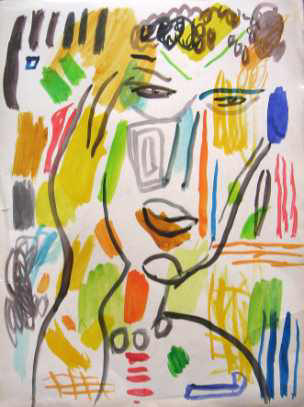Modern art (art which seemingly takes no talent and instead is a 'statement', rather than an expression of talent and beauty) was more or less popularized through the Dada movement. The Dada movement was started by a Jew named Tristan Tzara. Dadaism was admittedly an 'anti-art' movement, which in essence advocated that the 'statement' of the art was more important than the work that went into such art itself. Trzara was a man who would cut out random pieces of newspaper articles, place them in a hat, and then arbitrarily spread them across a table and call this 'poetry' (what talent!). Dadaism was a disgusting, Jewish form of 'art' that basically celebrating everything absurd and undesirable and gave no credence to beauty or talent. (For more on this, read this article).
This ridiculous, Jewish-rooted tendency to care more about the 'statement' (usually something provocative and abhorrent) than 'talent' or 'beauty' has had a disastrous effect on western civilization. Below is a brilliant BBC documentary focusing on the importance of beauty within art:
Let's now have a look at some examples of western art before, and after, heavy Jewish influence.
Music:
Above: The first movement of J.S. Bach's "Concerto in C Minor for Violin and Oboe", a piece written and preformed before massive Jewish influence in western music.
Above: "Rack City", a popular song of today by the 'artist' known as "Tyga". This song is heavily promoted in the Jewish-media despite featuring lyrics depicting lewd sexual acts with an elderly woman identified in the song's lyrics as a "grandma", and a more general undertone promoting the degradation of women.
Sculpture:
Above: Michelangelo's "David", a beautiful western sculpture before heavy Jewish artistic influence.

Above: a modern 'artistic' sculpture.
Poetry:
No one talks more than a Poet;
Fain he'd have the people know it.
Praise or blame he ever loves;
None in prose confess an error,
Yet we do so, void of terror,
In the Muses' silent groves.
What I err'd in, what corrected,
What I suffer'd, what effected,
To this wreath as flow'rs belong;
For the aged, and the youthful,
And the vicious, and the truthful,
All are fair when viewed in song.
Fain he'd have the people know it.
Praise or blame he ever loves;
None in prose confess an error,
Yet we do so, void of terror,
In the Muses' silent groves.
What I err'd in, what corrected,
What I suffer'd, what effected,
To this wreath as flow'rs belong;
For the aged, and the youthful,
And the vicious, and the truthful,
All are fair when viewed in song.
- To the Kind Reader, Johan Wolfgang von Goethe (1749 - 1832)
*
two smiles meet towards
the child-wheel of my zeal
the bloody baggage of creatures
made flesh in physical legends-lives
the nimble stags storms cloud over
rain falls under the scissors of
the dark hairdresser-furiously
swimming under the clashing arpeggios
in the machine's sap grass
grows around with sharp eyes
here the share of our caresses
dead and departed with the waves
gives itself up to the judgment of time
parted by the meridian of hairs
non strikes in our hands
the spices of human pleasures
the child-wheel of my zeal
the bloody baggage of creatures
made flesh in physical legends-lives
the nimble stags storms cloud over
rain falls under the scissors of
the dark hairdresser-furiously
swimming under the clashing arpeggios
in the machine's sap grass
grows around with sharp eyes
here the share of our caresses
dead and departed with the waves
gives itself up to the judgment of time
parted by the meridian of hairs
non strikes in our hands
the spices of human pleasures
- Vegetable Swallow, Tristan Tzara (1896 - 1963)
Painting:
Above: Michelangelo's "The Last Judgement", a beautiful work of art completely void of any Jewish artistic influence.

Above: 'modern art'
*
The Jew, who religiously despises work, simply cannot fathom why Europeans appreciate art which is the culmination of years of hard work and practice. The Jew clearly is hell bent on destroying the European idea of art and beauty, and replacing it with a repulsive, talentless cesspool of morally decadent filth. Ask yourself this honestly: was western art better before, or after, the heavy influence of the Jew?

